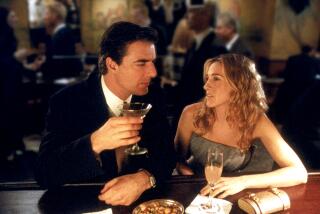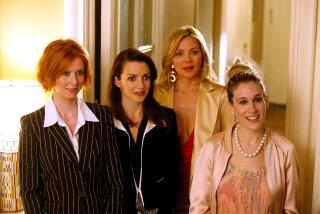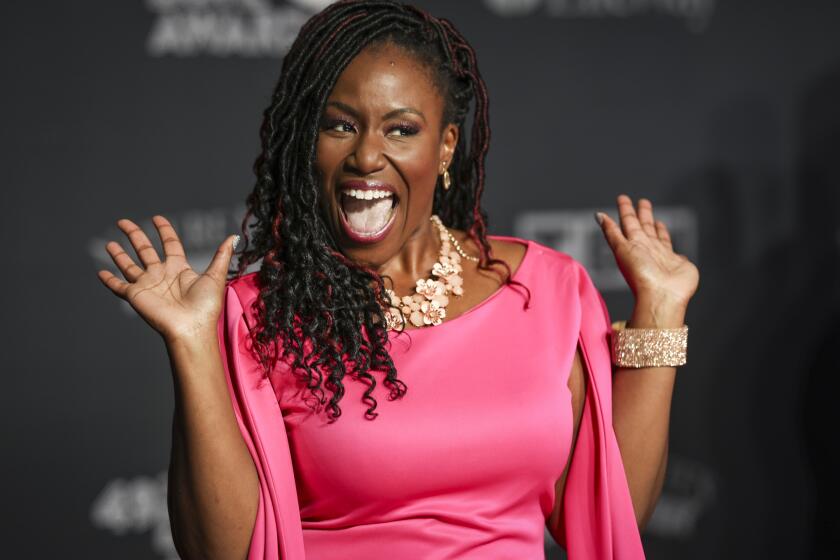‘Sex and the City’ was the frothy guilty pleasure this man needed. Until it wasn’t
I still remember the first episode of “Sex and the City” I saw after stumbling upon a marathon on HBO during a late night of bored channel surfing.
It’s the one where Carrie (Sarah Jessica Parker), miffed over being stood up by Mr. Big (Chris Noth), goes out with a sexy twentysomething who is fantastic in bed but not mature enough to realize toilet paper and coffee filters are a necessity to keep on hand.
“Sex and the City” was the frothy guilty pleasure I didn’t know I needed. It only took a few scenes to get me hooked on Carrie, Miranda (Cynthia Nixon), Samantha (Kim Cattrall) and Charlotte (Kristin Davis).
The drama was juicy. The sex was hot. The fashion exquisite. Carrie and her crew made New York City look like a fantasyland where martinis, swanky parties, fashion shows, brunches and hooking up was at the ready.
Did I mention how hot the sex was?
As a young black man growing up in the Midwest, I had absolutely zero in common with the women on screen, outside of sexual preference and ambitions to write a weekly column like Carrie Bradshaw – which happened for me in college, though it most certainly lacked the glamour and charm I had seen on TV (even if I had a ton of fun doing “research” for it).
When I discovered “Sex and the City,” I hadn’t even started high school. Yet I couldn’t get enough, binging episodes as often as I could. In fact, I loved the show so much it was one of the first series I collected as a box set along with “The Simpsons,” “Family Guy” and HBO’s prison drama, “Oz.”
Being a virgin, hormonal teenager who loved being swept away by a saccharine romantic comedy – at the time films such as “There’s Something About Mary,” “Booty Call” and “The Best Man” were frequent viewing – and raised on a TV diet that was almost exclusively limited to black sitcoms (“Martin,” “Moesha” and “Living Single,” to name a few), the series was unlike anything I had seen.
Much of my love for “Sex and the City” was directly linked to my experience watching it throughout high school, years where I was naive about everything related to dating, love and sex. While I tuned in religiously, the reality that I couldn’t connect much with what was happening on screen began to turn me off.
Really, it was a growing hunger for stories about people who looked, loved and lived like me and those around me — a craving that intensified as I began to experience more of life — that ultimately caused me to gravitate toward other shows.
Although it wasn’t nearly as tawdry, the women on “Girlfriends” felt more like the women who raised me and I can still hear the sound of my young mind exploding when I saw “Queer as Folk,” a series that showed me sex between two men on screen for the very first time years before Logo’s groundbreaking series “Noah’s Arc” would center stories around gay men who actually looked like me.
Revisiting “Sex and the City” during college ahead of the series’ 2008 film adaptation made it clear just how much of a fantasy Carrie, Miranda, Samantha and Charlotte really were.
By then I was years into my “age of uninnocence,” as Carrie said in the show’s pilot, and had been in enough relationships with guys like Mr. Big to know they were actually just awful, emotionally unavailable men. Actually, most of the characters on the show became a little more grating when I watched them with eyes that had seen more life.
As I connected with more diverse depictions of men and women, the world of “Sex and the City” felt increasingly one-dimensional. Though I could still enjoy so many of the story lines, I cringed at problematic moments the younger me didn’t catch like Samantha rocking an afro wig after chemo, Carrie’s fondness for “ghetto gold,” Charlotte’s racist mother-in-law and jokes that ran the gamut of homophobic and transphobic to sexist and sizeist.
In the nearly 15 years since the series went off the air, much has been made about its cultural contributions (or lack thereof) as critics and fans have reexamined its lasting legacy.
The internet is rife with think pieces and forums dedicated to everything from the show’s portrayal of gender and sexual politics on screen to its near laughable exclusion of people of color as series regulars.
Were they actually feminists or problematic women hung up on materialism and men? Was the series really any good? Did it actually change how women were perceived?
These aren’t things I ever thought while watching the show, although as I got older I have pondered how different the show might have been had it been fully conceived by women and not a man, which is no knock to creator Darren Star, whose early soaps “Beverly Hills, 90210” and “Melrose Place” I certainly tuned into as well.
While I admit thirtysomething me doesn’t have the same fondness for “Sex and the City,” the only thing that actually embarrasses me about loving the series is watching the abysmal second film more than once.
Carrie’s famous voice-overs did, however, gift me with one gem that I actually still try to live by today: “The most exciting, challenging and significant relationship of all is the one you have with yourself.”
Have a ‘Sex and the City’-level breakup story? We want to hear it! »
More to Read
The complete guide to home viewing
Get Screen Gab for everything about the TV shows and streaming movies everyone’s talking about.
You may occasionally receive promotional content from the Los Angeles Times.







